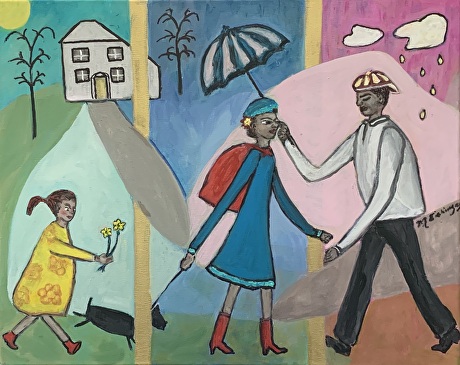
Life Rolls With Hope
Though troubles rain down, the couple makes sure their
child remains free from trauma and hardship.
The American Family
Last week, I wrote about friendship relationships and how they evolve and dissolve in our mobile technological society. This week’s blog delves into the altered structure of the nuclear family and its impact on schools and the community.
As a mother of five and grandmother of eight young adults, I am fortunate that we live in the same time zone, though I admit to being sad that I wasn’t there when my grandchildren were growing up. The African saying that it takes a village to raise a child didn’t include me. My children spent most of their childhood in a traditional nuclear family, with both parents in a stable household. Though I divorced before they graduated high school, their father and I shared responsibilities, ensuring the children were cared for and didn’t play one parent against the other. I saw them daily since my ex and I lived in the same school district. Our children woke up at one house and went to bed at the other parent’s home.
In the 1950s, most women were married by twenty and men by twenty-four. Over half the women gave birth to their first child before reaching twenty-three. There were more children and fewer divorces in my generation than there are today. In the 1970s, 73% of children resided with two parents in their first marriage, but that number declined to 25 % by 2019 due to economic and societal changes. Twenty percent of today’s children must deal with custody-arranged divorces involving remarried parents. With so many blended families, the stigma of divorce lessened.
A 2022 Gallup poll reports that 95 percent of Americans approve of interracial marriages, a significant change from the 4 percent in 1958. But, it wasn’t until 1967, with Loving v. Virginia, that interracial marriages were legalized nationwide. Government statistics show that 10 percent of today’s population are in mixed-race unions. By the end of the last century, their offspring and the increase in international adoptions added to schoolroom diversity. Children not seeing themselves in the image of their parents or
neighbors contributed to confusion, shame, and questioning. School districts began recognizing the importance of preparing teachers to manage culturally diverse classrooms.
International adoptions peaked at nearly 23,000 in 2004, falling to 1,784 in 2021. The decline was influenced in 1993 by The Hague Adoption Convention’s policies requiring a paper trail to establish the identity and history of legal custody. With an increasing number of countries arguing that children belong in the land of their birth, foreign adoptions from second and third-world countries are rare. The Indian Child Welfare Act of 1978 made it nearly impossible to adopt Native American children.
In 2015, with American society more tolerant, the Supreme Court gave the LGBTQ community the right to marry and adopt children. This right was enshrined into federal law in ’22. Today, an estimated six million American children have an LGBTQ parent, according to the UCLA School of Law Williams Institute.
With the societal acceptance of single motherhood and LGBTQ parenting, many expect last year’s Supreme Court abortion ruling to increase available infants. So far, that has not happened. Family Trend magazine reports that the number of potential parents waiting for infants remains the same. However, laws have changed for the 130,000 children that do get adopted. Sixty percent are in open adoptions where birth parents are involved in their children’s lives. Numerous studies show that adoptees feel more secure when they know their origin.
The nation’s birthrate is at a historic low. With women. on average, marrying at 28 years and men at 30, the age to birth a first child also climbed. And, though women still earn less than men, many stay focused on careers, deciding to have fewer children or forgo child-rearing altogether. Juggling young ones and schooling them while maintaining a full-time job is quite a challenge, especially if you don’t have financial resources.
Multi-generational families more common since the recession of 2007 and the COVID-19 pandemic. According to Pew Research Center, 18 percent of families are multi-generational compared to 7 percent in 1972. Now that younger adults marry later, they remain in their childhood homes longer, especially men. Though not as common as in other countries, the number of aging parents living with adult children continues to increase for financial and psychological health reasons.
Changing norms about money, work, marriage, and kids can be summed up by the fact that last year, Americans moved at the lowest rate since 1948. It may feel like people are fleeing cities for rural and suburban areas, but the statistics show differently. Eighty percent of the population resides within one hundred miles from where they grew up. CBS reports that the reasons for not moving are reflected by the aging population and their need for care at one end of the spectrum and the need for childcare at the other end. Other factors are declining marriage rates, high housing costs, the expense of driving, and the rise of two-income households. A person accepting employment in a new location may interrupt their partner’s career. According to INSIDER, a business magazine, being unwilling or unable to move can prevent families from improving their financial standings.
Lots of people are happy to live near their families in the town where they were born. They have strong social connections in their communities and wouldn’t trade them for anything else. The rise in remote work allowed many to remain in their hometowns, but it also gave some the flexibility to move to a preferred location. It remains to be seen whether enough people with remote jobs will choose to go elsewhere and reverse the trend to stay local once more.
Last week’s blog about deep friendships and this week’s missile about close family ties shed light on the importance of meaningful connections. We need acquaintances that will consider our feelings and listen to our deepest thoughts–people you willingly help that will reciprocate when needed.
If you were a politician with this information, would you use it to impact city planning? What would you do to combat loneliness and isolation?
Please comment at below.
Art is always for sale; Life Rolls With Hope is a 16 x 20 acrylic on canvas painting available for $395, including shipping. To make arrangements, contact me at marilynne@eichingerfineart.com
References:
Mauer, B. (2023)The changing Face of the American Family. Parents. retrieved from https://www.parents.com/parenting/dynamics/the-changing-face-of-the-american-family/
Hogan, C. (2022) What Open Adoptions is Really Like. Parents. retrieved from https://www.parents.com/what-open-adoption-is-really-like-6834746
Website (2022) Pew Research Center. retrieved from https://www.pewresearch.org/social-trends/2022/03/24/the-demographics-of-multigenerational-households/
Website (2017) Why are international options on the decline? Nightlight Christian adoptions. Retrieved from https://nightlight.org/2017/10/international-adoptions-decline/#:~:text=Hague%20requirements,their%20history%20of%20legal%20custody
Drah, H. (2023) 24 Groundbreaking Interracial Marriage Statistics for 2023. 2Date4Love. retrieved from https://2date4love.com/interracial-marriage-statistics/
Zinkula, J. (2022) Most Americans never move far from their hometown. Insider. retrieved from https://www.businessinsider.com/americans-are-moving-less-social-demographic-changes-2022-8
